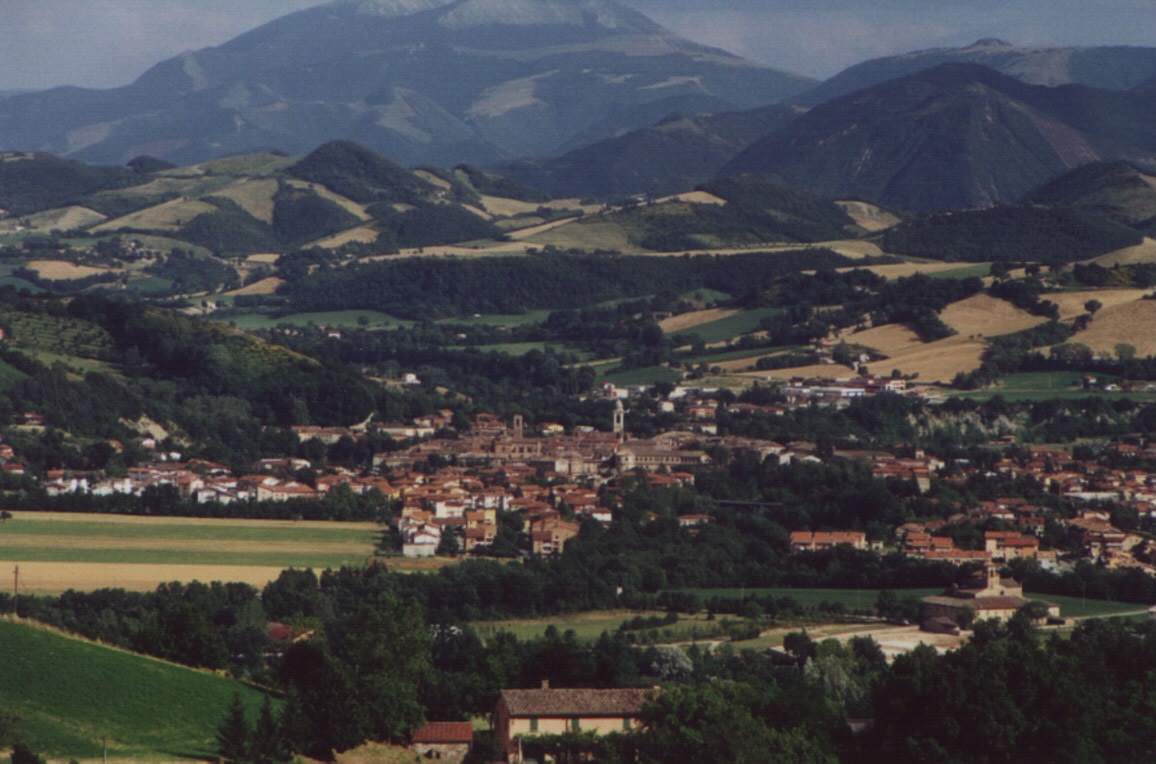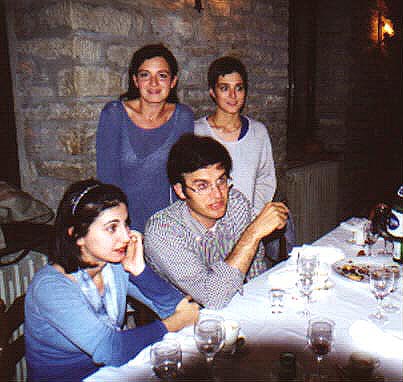
View of Urbania from Peglio
"I Della Rovere nell'Italia delle Corti" ("The Della Rovere in the Italy of the Courts")
Urbania, Italy
16-19 September 1999

View of Urbania from Peglio |
"I Della Rovere nell'Italia delle Corti" ("The Della Rovere in the Italy of the Courts") Urbania, Italy
|
| For four days last September, some 40 scholars and many more attendees traveled to Urbania, a picturesque town in the Marches, to explore the impact of the Della Rovere dukes on the art, politics, and culture of their time. The fall weather was unusually warm, but Urbania's hospitality was warmer still, and all participants agreed that this, the first major international conference held in this small town, was an unequivocal success. |
| Much smaller and less well known than Urbino, 20 kilometers away and the principal ducal residence, Urbania - called Casteldurante during the Renaissance - has become an active regional cultural center. The Civic Museum, housed together with the communal archives and library in the Renaissance Ducal Palace, contains an important selection of the colorful maiolica ceramic ware that was Casteldurante's most important manufacture in the sixteenth century, as well as a significant collection of drawings and prints. Under the leadership of its director, Dr. Feliciano Paoli, the museum has, during the past few years, hosted a number of exhibitions based on its own holdings, but this conference was by far the most ambitious. |
 |
| Responsibility for the selection of speakers and general organization was the province of a coordinating committee composed of Bonita Cleri, Angelo De Angelis, Sabine Eiche, John Law, and Dr. Paoli. The scope of both the conference theme and the number and the variety of speakers required substantial resources. In addition to Italian cultural and academic entities (the Assessorato alla Cultura, Regione Marche, of the Servizio Beni e Attivit Culturali, the Universit degli Studi di Urbino, the Fondazione Cassa di Risparmio di Pesaro, and the Soprintendenza ai Beni Artistici e Storici delle Marche - Urbino), Renaissance Studies itself collaborated in sponsoring the conference. Renaissance Studies was also a tangible presence during the conference, in the person of Philip Joseph, editor of humanities journals for Oxford University Press, who had brought a table-full of relevant publications as well as copies of the journal. Other books on appropriate topics were provided by Giovanni Carnevali, representing Editoriale Umbra and the publishing arm of the Accademia Raffaello. Perhaps most impressive was the active support and participation of the local government of Urbania, whose mayor, Giuseppe Lucarini, welcomed us and remained a constant presence throughout the four days. |
| As for the conference itself, we who participated in it agreed that the organizers had done a splendid job. Participation was truly interdisciplinary, with speakers representing a wide range of interests and expertise. Most presenters were Italian, but six came from Great Britain and one from the United States, and I will mention those here. Topics ranged from political to cultural history (Cecil Clough, John Law, Hugh Brigstocke), with particular attention to the ceramic ware for which the area was famous (Timothy Wilson, John V. G. Mallet). A number of speakers addressed architectural issues, including consideration of ducal villas that no longer exist and evidence for the now-lost ducal library at Casteldurante (Warren Boutcher), and one presented material drawn from the Urbania archives on a sixteenth-century woman, Cornelia Collonelli (Deborah Stott). |
| In addition to the intellectual stimulation of our sessions at the Ducal Palace, we were treated in the evenings to a selection of the best restaurants in the area, allowing participants the opportunity to exchange ideas, information, and humor as we shared wine and pasta. This was yet more evidence of the attention to detail practiced by the coordinating committee, as all arrangements came off without a hitch. Menu decisions had already been made, and we could just relax and enjoy the surroundings and each other. Many, many bravos to all those who made this such an informative and enjoyable time. |
| On a sadder note: Father Leonard Boyle, longtime director of the Vatican Libraries and friend to hundreds of grateful scholars, delivered the inaugural address in Urbania, offering us the example of his learning and grace. Just one month later, he died in Rome. We are happy to have been able to be with him one last time. |
| Deborah Stott, Bulletin of the Society of Renaissance Studies, Newsletter, 18/1, 2000, 33-34 |